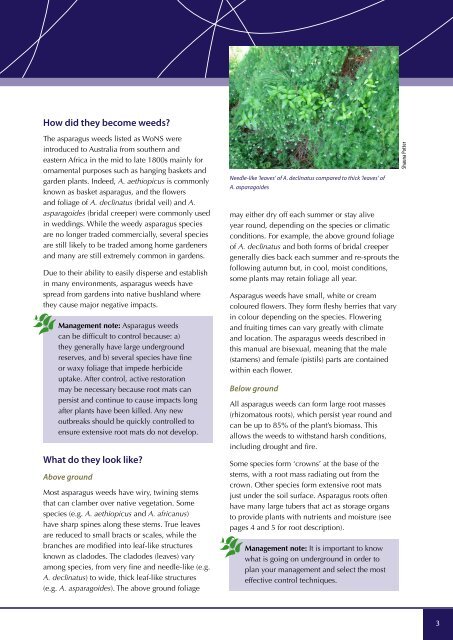Section 1. Biology and Threat - Weeds Australia
Section 1. Biology and Threat - Weeds Australia
Section 1. Biology and Threat - Weeds Australia
- No tags were found...
Create successful ePaper yourself
Turn your PDF publications into a flip-book with our unique Google optimized e-Paper software.
How did they become weeds?The asparagus weeds listed as WoNS wereintroduced to <strong>Australia</strong> from southern <strong>and</strong>eastern Africa in the mid to late 1800s mainly forornamental purposes such as hanging baskets <strong>and</strong>garden plants. Indeed, A. aethiopicus is commonlyknown as basket asparagus, <strong>and</strong> the flowers<strong>and</strong> foliage of A. declinatus (bridal veil) <strong>and</strong> A.asparagoides (bridal creeper) were commonly usedin weddings. While the weedy asparagus speciesare no longer traded commercially, several speciesare still likely to be traded among home gardeners<strong>and</strong> many are still extremely common in gardens.Due to their ability to easily disperse <strong>and</strong> establishin many environments, asparagus weeds havespread from gardens into native bushl<strong>and</strong> wherethey cause major negative impacts.Management note: Asparagus weedscan be difficult to control because: a)they generally have large undergroundreserves, <strong>and</strong> b) several species have fineor waxy foliage that impede herbicideuptake. After control, active restorationmay be necessary because root mats canpersist <strong>and</strong> continue to cause impacts longafter plants have been killed. Any newoutbreaks should be quickly controlled toensure extensive root mats do not develop.What do they look like?Above groundMost asparagus weeds have wiry, twining stemsthat can clamber over native vegetation. Somespecies (e.g. A. aethiopicus <strong>and</strong> A. africanus)have sharp spines along these stems. True leavesare reduced to small bracts or scales, while thebranches are modified into leaf-like structuresknown as cladodes. The cladodes (leaves) varyamong species, from very fine <strong>and</strong> needle-like (e.g.A. declinatus) to wide, thick leaf-like structures(e.g. A. asparagoides). The above ground foliageNeedle-like ‘leaves’ of A. declinatus compared to thick ‘leaves’ ofA. asparagoidesmay either dry off each summer or stay aliveyear round, depending on the species or climaticconditions. For example, the above ground foliageof A. declinatus <strong>and</strong> both forms of bridal creepergenerally dies back each summer <strong>and</strong> re-sprouts thefollowing autumn but, in cool, moist conditions,some plants may retain foliage all year.Asparagus weeds have small, white or creamcoloured flowers. They form fleshy berries that varyin colour depending on the species. Flowering<strong>and</strong> fruiting times can vary greatly with climate<strong>and</strong> location. The asparagus weeds described inthis manual are bisexual, meaning that the male(stamens) <strong>and</strong> female (pistils) parts are containedwithin each flower.Below groundAll asparagus weeds can form large root masses(rhizomatous roots), which persist year round <strong>and</strong>can be up to 85% of the plant’s biomass. Thisallows the weeds to withst<strong>and</strong> harsh conditions,including drought <strong>and</strong> fire.Some species form ‘crowns’ at the base of thestems, with a root mass radiating out from thecrown. Other species form extensive root matsjust under the soil surface. Asparagus roots oftenhave many large tubers that act as storage organsto provide plants with nutrients <strong>and</strong> moisture (seepages 4 <strong>and</strong> 5 for root description).Management note: It is important to knowwhat is going on underground in order toplan your management <strong>and</strong> select the mosteffective control techniques.Shauna Potter3
















